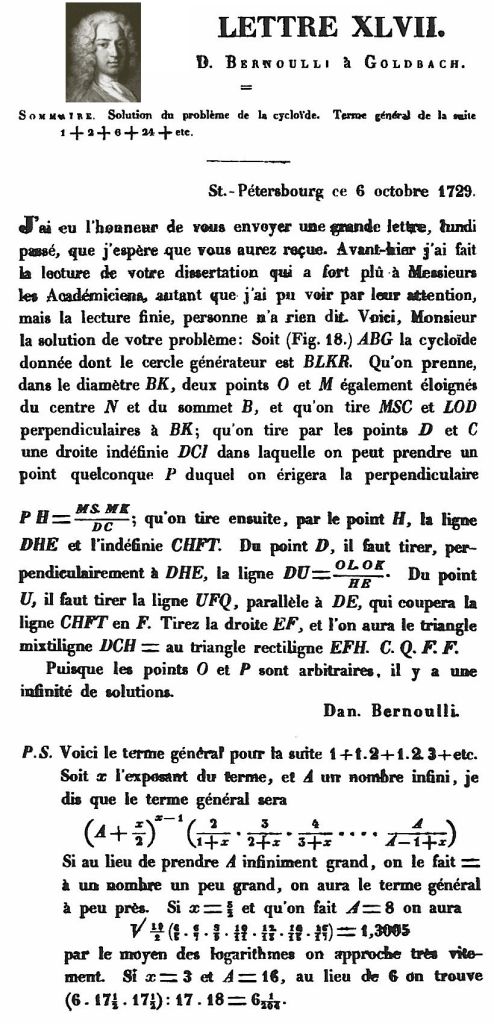 Daniel Bernoulli
Daniel Bernoulli
Interpolating the natural factorial n!
or
The birth of the real factorial function
(1729 - 1826)
The following exposition relies on "Why is the gamma function so as it is?" by Detlef Gronau, Teaching Mathematics and Computer Science, 1/1 (2003), 43-53.
Definitions:
For real
 let
let  .
.
For real  let
let  .
.
Note: The following formulas are reconstructions in modern parlance. The notations used are different from those in the original papers!
(1) October 6, 1729, Daniel Bernoulli, Letter to Goldbach:

(2) October 13, 1729, Leonhard Euler, Letter to Goldbach:

(3) January 8, 1730, Leonhard Euler, Letter to Goldbach:

(4) 1768, Leonhard Euler, Institutionem calculi integralis:

(5) 1826, A. M. Legendre, Traité des fonctions elliptiques et des integrals Eulériennes: Same as Euler's 1768 definition.

There are six noteworthy facts:
(1) The interest of Christian Goldbach in the problem of interpolating the natural factorial n! to real
(positive) values was a driving force in the course which gave birth to the gamma function.
(2) The first known representation of an interpolating function of the factorial was given by Daniel Bernoulli, not Leonhard Euler.
(3) The first definition of Euler (1729) bears the name of Gauss, obviously erroneously.
(4) The definition of Daniel Bernoulli converges faster to the limit than that of Euler.
(5) Euler changed his definition between 1729/30 and 1768. The change is equivalent to a move from x! to Gamma(x).
(6) Legendre took on the 1768 definition of Euler, but he did not introduce the transition from x! to Gamma(x).
Daniel Bernoulli's letter to Goldbach from 1729-10-06 giving the first representation of an interpolating function of the factorials in form of an infinite product, later known as the gamma function. Published by Paul Heinrich Fuss, Correspondance mathématique et physique de quelques célèbres géomètres du XVIIIeme siècle .., St. Pétersbourg, 1843, Tome II, page 324-325.

Scan by Bruce Arnold, released into the public domain.
The formula reads in modern notation as given by Gronau

|
See also this discussion on MathOverflow.
In a comment Jonas Meyer asked: "I'm still curious (...): If this correspondence was well documented by Fuss in the 19th century, why did so many 20th century scholars fail to acknowledge Bernoulli's contribution? "
Bruce Arnold answered:
"I think Davis's Chauvenet Prize article
Leonhard Euler's Integral: A Historical Profile of the Gamma Function
makes a serious error in not mentioning Daniel Bernoulli's letter and
solution. I just looked it up again: Davis gives only Tome I of Fuss's
'Correspondance' as reference, whereas Daniel's letter is in Tome II.
Perhaps Davis missed this important source. Later his mistake was passed
down by 'argumentum ad verecundiam' (which is the Latin translation of
'according to Wikipedia'. :)"
Euler's letter to Goldbach 15 october 1729 (infinite product) :
http://www.math.dartmouth.edu/~euler/correspondence/letters/OO0715.pdf
Euler's letter to Goldbach 8 january 1730 (integral) :
http://www.math.dartmouth.edu/~euler/correspondence/letters/OO0717.pdf
Euler's formula for the future 'Beta' function 1768 :
http://www.math.dartmouth.edu/~euler/docs/originals/E342sec1ch9.pdf
Gauss Pi function at page 146 of "Disquisitiones generales circa seriem infinitam" 1813:
http://dz-srv1.sub.uni-goettingen.de/sub/digbib/loader?did=D256249
Legendre's books "Traité des fonctions elliptiques et des intégrales eulériennes" 1826
(Gamma at page 365/371 of T II):
http://gallica.bnf.fr/Catalogue/noticesInd/FRBNF30775993.htm#listeUC
To be complete let's add Euler's older (1729) paper in Latin (and in English!):
http://math.dartmouth.edu/~euler/pages/E019.html
![]() Back to the Homepage of Factorial Algorithms.
Back to the Homepage of Factorial Algorithms.